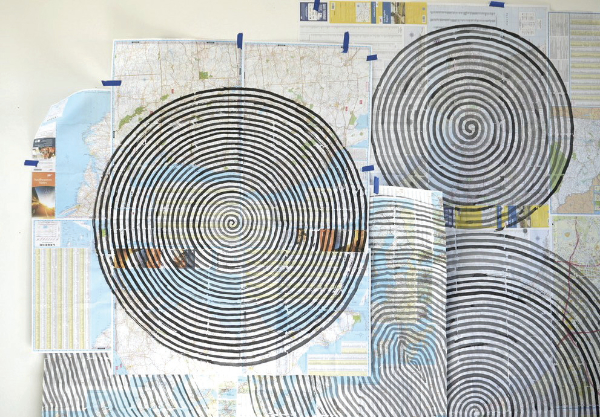Migration Patterns
By Edie Tsong
In 2001, when I first arrived at the Roswell Artist-in-Residence program, a man followed me around the Farmer’s Country Market. Had he never seen an Asian in person? Throughout the year, I blocked out the constant stares.
In those days, we still had thick telephone books with thin newsprint pages. I decided to write each name listed in Roswell’s white pages on lined notebook paper. Using a No. 2 pencil, I wrote in the consistent looping slant of standard cursive I had learned in school and connected the names in a long continuum. After all, we share a connection when we live in the same city.
As I wrote, I unwittingly traced migration patterns. The multiple Arceneaux, a common name in Louisiana where I had previously lived, might have come from France, crossed the Atlantic to New Orleans, traveled up the Mississippi to Missouri, and traveled along the Santa Fe Trail to arrive in New Mexico. The abundant Williams and Smiths, who might have come via Plymouth Rock, were as common as more than thirty Trujillos, a name originating in Spain that crossed the ocean to end up here. Names like Patel and Tsering spoke to recent migrations from Asia. When I got to the T’s, I added my name, writing myself into the community.
Twenty years later, shortly after both my parents died, I returned for another residency in Roswell. My parents had immigrated from Taiwan following the 1965 Immigration Act. They raised my sisters and me in Pennsylvania before returning to Taiwan, where my father worked another two decades as a physicist. They retired in the Pacific Northwest where they knew very few people. They didn’t need community the way I did, a daughter of immigrants never connected to a homeland.
Throughout late fall at the new artist-in-residence compound just six miles from Bitter Lake National Wildlife Refuge, the call of sandhill cranes and snow geese could be heard in the mornings and evenings. I’d look at the sky to see long staggered lines and V formations of migrating birds.
I pasted maps of cities, states, and other countries together to form large sheets of paper, creating a fragmented world with borders askew. Using sumi ink and brush, as my dad used for Chinese calligraphy, I started in the center of a large map and painted a line spiraling out. The brush crossed cities my parents had brought us to, including Albuquerque. I crossed cities and borders I visited alone or with friends and thought of how far I had come.
I knew little about my lineage, but through the creative process, I came to know Roswell’s. It was an unexpected place to return for creative nourishment over the years. In creating the maps, I came to understand that our lineages include the places and communities we have been a part of.
—
Edie Tsong (Taiwanese American) is an interdisciplinary artist, writer, and musician. She is a Blackburn Fellow at the Randolph MFA in Creative Writing program and plays in the improvisational quartet Lost Time. edietsong.com.

